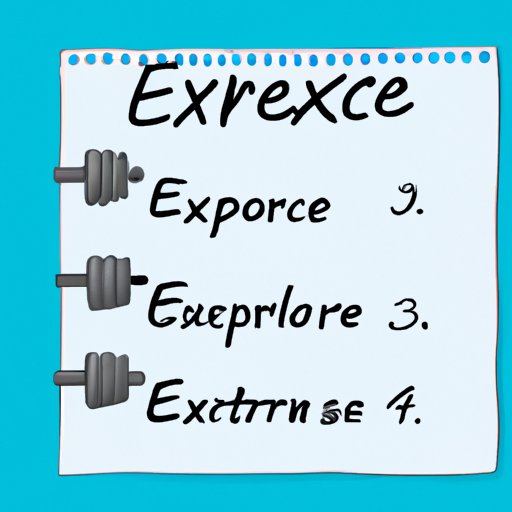
Introduction
Exercise is an essential part of a healthy lifestyle. However, determining how often you should exercise can be challenging. Many people struggle to find the balance between exercising enough to see results and avoiding burnout and injury. In this article, we’ll explore how often you should exercise and how to create an effective workout plan that works for you.
The Ultimate Guide to Creating a Workout Plan That Works for You: How Often Should You Exercise?
One of the best ways to ensure that you’re exercising at the right frequency is to create a workout plan that is tailored to you. A personalized workout plan takes into account individual factors such as age, fitness levels, health goals, and lifestyle.
To create a personalized workout plan, start by setting specific goals. Do you want to lose weight, tone your muscles, or increase your endurance? Once you’ve determined your goals, consider your fitness level and the types of exercises that you enjoy. Choose a variety of exercises, including cardiovascular and strength training, and schedule your workouts throughout the week.
It’s essential to listen to your body and adjust your plan as needed. If you feel too tired to exercise one day, don’t push yourself too hard. Rest and recovery are critical components of a successful workout plan.
Finding the Sweet Spot: How Frequently You Should Exercise to Maximize Health Benefits
The American Heart Association recommends at least 150 minutes of moderate-intensity aerobic activity or 75 minutes of vigorous aerobic activity per week, which can be broken down into 30 minutes per day, five days per week.
The type and duration of exercise depend on individual factors such as age, fitness levels, and health conditions. Generally, moderate-intensity exercise includes activities such as brisk walking or water aerobics, while vigorous-intensity exercise includes running, cycling, or swimming at a fast pace.
Following these guidelines can have many health benefits, including improving heart health, reducing the risk of chronic diseases such as obesity and diabetes, and promoting mental well-being.
Examples of fitness plans that meet the recommended frequency and duration of workouts include a mix of cardio and strength training activities. This might include a combination of jogging, cycling, swimming, weightlifting, and yoga.
Busting Exercise Myths: Why More Isn’t Necessarily Better When It Comes to Your Workout Routine
Many people believe that the more they exercise, the better. However, this is a common misconception that can lead to burnout and injury.
Over-exercising can have negative effects on your body, including increased risk of injury, decreased immune function, and hormonal imbalances. It’s essential to find a balance that works for you, which includes rest and recovery days.
It’s also important to remember that everyone’s body is different. While some people may see results with less exercise, others may need more to achieve their fitness goals. Listening to your body is key to finding the right balance.
Making Exercise a Habit: A Beginner’s Guide to Determining the Ideal Exercise Frequency
Starting an exercise routine can be intimidating, but it is one of the best things you can do for your health. To establish a workout routine, start small and gradually increase the frequency and intensity of your workouts.
Begin with a simple goal, such as taking a 15-minute walk every day. As you become more comfortable and confident, increase the duration and intensity of your workouts. Remember to listen to your body and rest when needed.
Tracking your progress can also help you stay motivated and make adjustments to your routine as needed. Use a fitness tracker or app to monitor your workouts and set realistic goals for yourself.
Tailoring Your Exercise Routine to Your Lifestyle: Finding the Right Exercise Frequency for Your Busy Schedule
For many people, finding time to exercise can be a challenge. However, a busy lifestyle should not be a barrier to physical activity. Look for ways to incorporate exercise into your daily routine, such as taking the stairs instead of the elevator or walking or cycling to work.
Short, high-intensity workouts such as HIIT or circuit training can also be effective for busy individuals. These workouts can be as short as 20-30 minutes and can be done anywhere, making them a great option for people with limited time.
Remember, every little bit helps. Even if you can only fit in a few minutes of exercise each day, it’s better than doing nothing at all.
Conclusion
Determining how often you should exercise can be challenging, but it’s an essential part of a healthy lifestyle. By creating a personalized workout plan, following recommended exercise guidelines, avoiding exercise myths, making exercise a habit, and tailoring your routine to your lifestyle, you can find the ideal exercise frequency for your individual needs and goals.
Remember, exercise should be enjoyable, sustainable, and realistic. Find the right balance, listen to your body, and you’ll be well on your way to achieving your fitness goals and improving your overall health and well-being.




